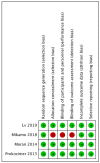Tedizolid Versus Linezolid for the Treatment of Acute Bacterial Skin and Skin Structure Infection: A Systematic Review and Meta-Analysis
- PMID: 31487837
- PMCID: PMC6784229
- DOI: 10.3390/antibiotics8030137
Tedizolid Versus Linezolid for the Treatment of Acute Bacterial Skin and Skin Structure Infection: A Systematic Review and Meta-Analysis
Abstract
This meta-analysis aims to assess the efficacy and safety of tedizolid, compared to linezolid, in the treatment of acute bacterial skin and skin structure infection (ABSSSI). PubMed, Web of Science, EBSCO (Elton B. Stephens Co.), Cochrane Library, Ovid Medline and Embase databases were accessed until 18 July 2019. Only randomized controlled trials (RCTs) comparing the efficacy of tedizolid with linezolid for adult patients with ABSSSIs were included. The outcomes included the clinical response, microbiological response, and risk of adverse events (AEs). A total of four RCTs involving 2056 adult patients with ABSSSI were enrolled. The early clinical response rate was 79.6% and 80.5% for patients receiving tedizolid and linezolid, respectively. The pooled analysis showed that tedizolid had a non-inferior early clinical response rate to linezolid (odds ratio (OR) = 0.96, 95% confidence interval (CI) = 0.77-1.19, I2 = 0%). The early response rate was similar between tedizolid and linezolid among patients with cellulitis/erysipelas (75.1% vs. 77.1%; OR = 0.90, 95% CI = 0.64-1.27, I2 = 25%), major cutaneous abscess (85.1% vs. 86.8%; OR = 0.93, 95% CI = 0.42-2.03, I2 = 37%) and wound infection (85.9% vs. 82.6%; OR = 1.29, 95% CI = 0.66-2.51, I2 = 45%). For methicillin-resistant Staphylococcus aureus patients, tedizolid had a favorable microbiological response rate of 95.2% which was comparable to linezolid (94%) (OR = 1.19, 95% CI = 0.49-2.90, I2 = 0%). In addition to the similar risk of treatment-emergent AEs (a serious event, the discontinuation of the study drug due to AEs and mortality between tedizolid and linezolid), tedizolid was associated with a lower risk of nausea, vomiting and abnormal neutrophil count than linezolid. In conclusion, once-daily tedizolid (200 mg for six days) compared to linezolid (600 mg twice-daily for 10 days) was non-inferior in efficacy in the treatment of ABSSSI. Besides, tedizolid was generally as well tolerated as linezolid, and had a lower incidence of gastrointestinal AEs and bone marrow suppression than linezolid.
Keywords: acute bacterial skin and skin structure infection; linezolid; tedizolid.
Conflict of interest statement
The authors declare no conflict of interest.
Figures





Similar articles
-
Efficacy and Safety of Tedizolid and Linezolid for the Treatment of Acute Bacterial Skin and Skin Structure Infections in Injection Drug Users: Analysis of Two Clinical Trials.Infect Dis Ther. 2018 Dec;7(4):509-522. doi: 10.1007/s40121-018-0211-4. Epub 2018 Sep 21. Infect Dis Ther. 2018. PMID: 30242736 Free PMC article.
-
Tedizolid phosphate vs linezolid for treatment of acute bacterial skin and skin structure infections: the ESTABLISH-1 randomized trial.JAMA. 2013 Feb 13;309(6):559-69. doi: 10.1001/jama.2013.241. JAMA. 2013. PMID: 23403680 Clinical Trial.
-
Tedizolid and Linezolid for Treatment of Acute Bacterial Skin and Skin Structure Infections of the Lower Extremity versus Non-Lower-Extremity InfectionsPooled Analysis of Two Phase 3 Trials.J Am Podiatr Med Assoc. 2017 Jul;107(4):264-271. doi: 10.7547/15-218. Epub 2016 Aug 17. J Am Podiatr Med Assoc. 2017. PMID: 27533787
-
Tedizolid: a novel oxazolidinone with potent activity against multidrug-resistant gram-positive pathogens.Drugs. 2015 Feb;75(3):253-70. doi: 10.1007/s40265-015-0352-7. Drugs. 2015. PMID: 25673021 Review.
-
Tedizolid: The First Once-Daily Oxazolidinone Class Antibiotic.Clin Infect Dis. 2015 Oct 15;61(8):1315-21. doi: 10.1093/cid/civ501. Epub 2015 Jun 23. Clin Infect Dis. 2015. PMID: 26105167 Review.
Cited by
-
Tedizolid: new data and experiences for clinical practice.Rev Esp Quimioter. 2021 Sep;34 Suppl 1(Suppl1):22-25. doi: 10.37201/req/s01.06.2021. Epub 2021 Sep 30. Rev Esp Quimioter. 2021. PMID: 34598418 Free PMC article. Review.
-
Antibiotic Resistance to Molecules Commonly Prescribed for the Treatment of Antibiotic-Resistant Gram-Positive Pathogens: What Is Relevant for the Clinician?Pathogens. 2024 Jan 19;13(1):88. doi: 10.3390/pathogens13010088. Pathogens. 2024. PMID: 38276161 Free PMC article. Review.
-
Discovery of Antibacterial Contezolid Acefosamil: Innovative O-Acyl Phosphoramidate Prodrug for IV and Oral Therapies.ACS Med Chem Lett. 2022 Jun 29;13(7):1030-1035. doi: 10.1021/acsmedchemlett.2c00191. eCollection 2022 Jul 14. ACS Med Chem Lett. 2022. PMID: 35859881 Free PMC article.
-
Pharmacokinetic/Pharmacodynamic Analysis of Tedizolid Phosphate Compared to Linezolid for the Treatment of Infections Caused by Gram-Positive Bacteria.Antibiotics (Basel). 2021 Jun 22;10(7):755. doi: 10.3390/antibiotics10070755. Antibiotics (Basel). 2021. PMID: 34206434 Free PMC article.
-
New Antibiotics for Staphylococcus aureus Infection: An Update from the World Association of Infectious Diseases and Immunological Disorders (WAidid) and the Italian Society of Anti-Infective Therapy (SITA).Antibiotics (Basel). 2023 Apr 12;12(4):742. doi: 10.3390/antibiotics12040742. Antibiotics (Basel). 2023. PMID: 37107104 Free PMC article. Review.
References
-
- Garau J., Ostermann H., Medina J., Avila M., McBride K., Blasi F. Current management of patients hospitalized with complicated skin and soft tissue infections across Europe (2010–2011): Assessment of clinical practice patterns and real-life effectiveness of antibiotics from the REACH study. Clin. Microbiol. Infect. 2013;19:E377–E385. doi: 10.1111/1469-0691.12235. - DOI - PubMed
-
- Bassetti M., Baguneid M., Bouza E., Dryden M., Nathwani D., Wilcox M. European perspective and update on the management of complicated skin and soft tissue infections due to methicillin-resistant Staphylococcus aureus after more than 10 years of experience with linezolid. Clin. Microbiol. Infect. 2014;20(Suppl. 4):3–18. doi: 10.1111/1469-0691.12463. - DOI - PubMed
LinkOut - more resources
Full Text Sources

